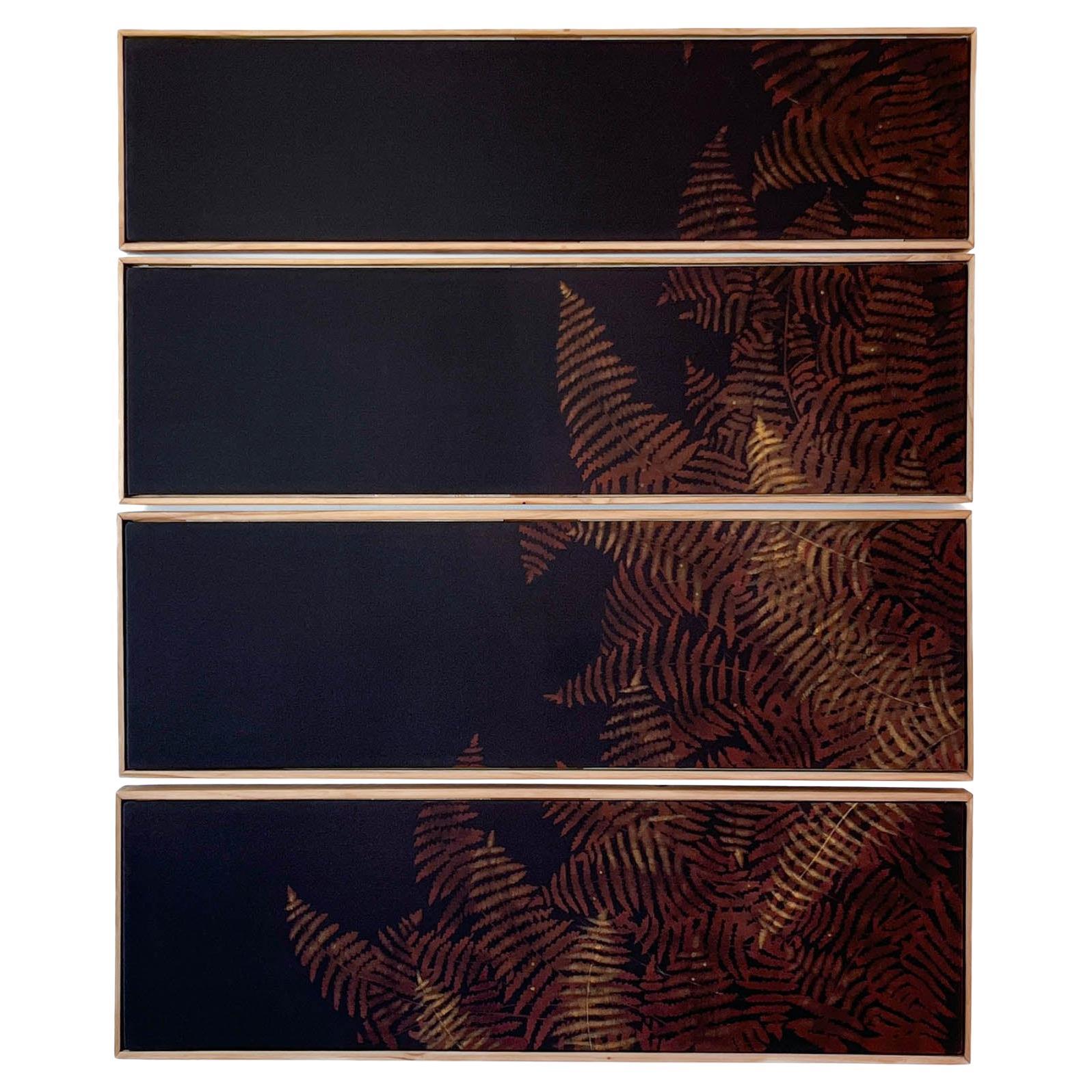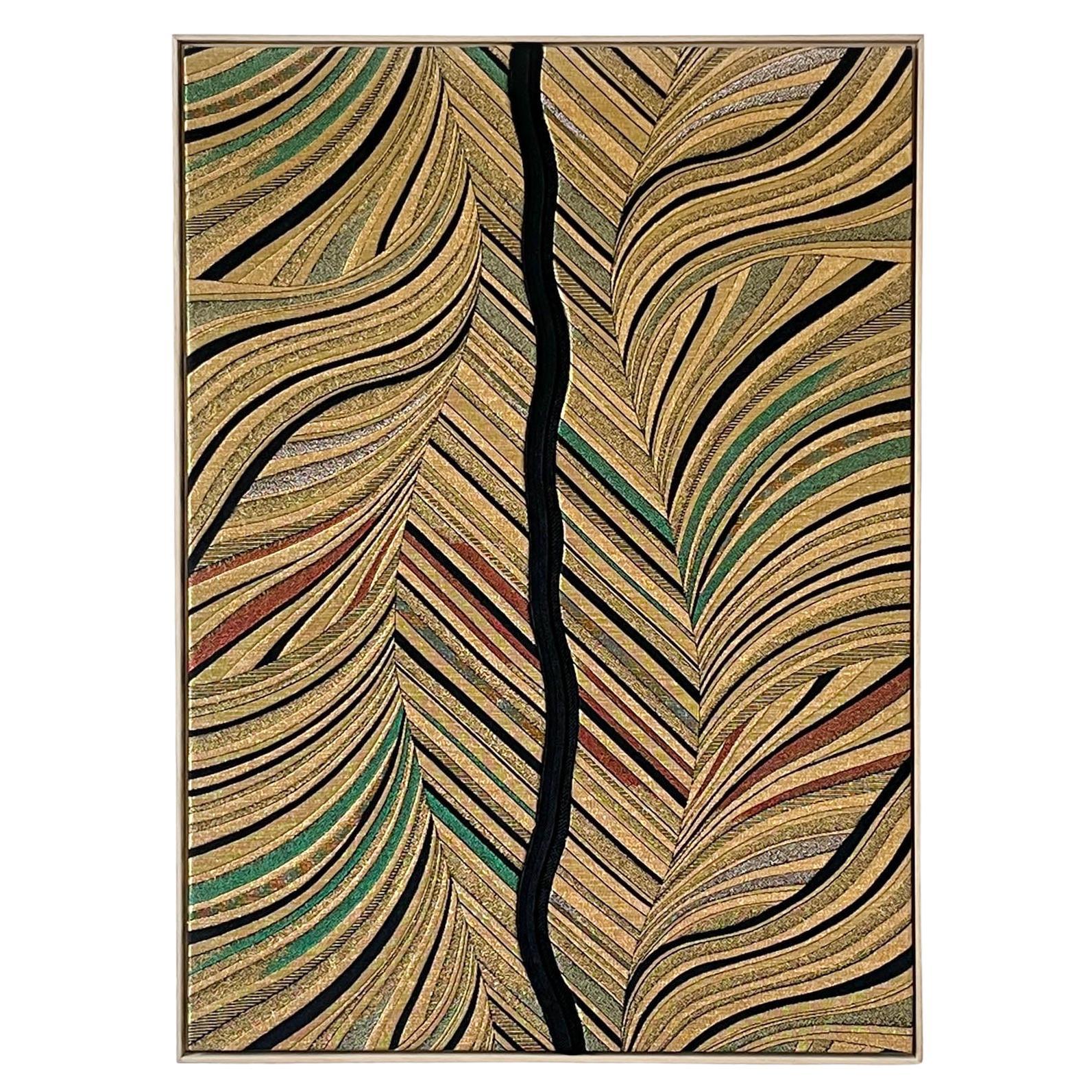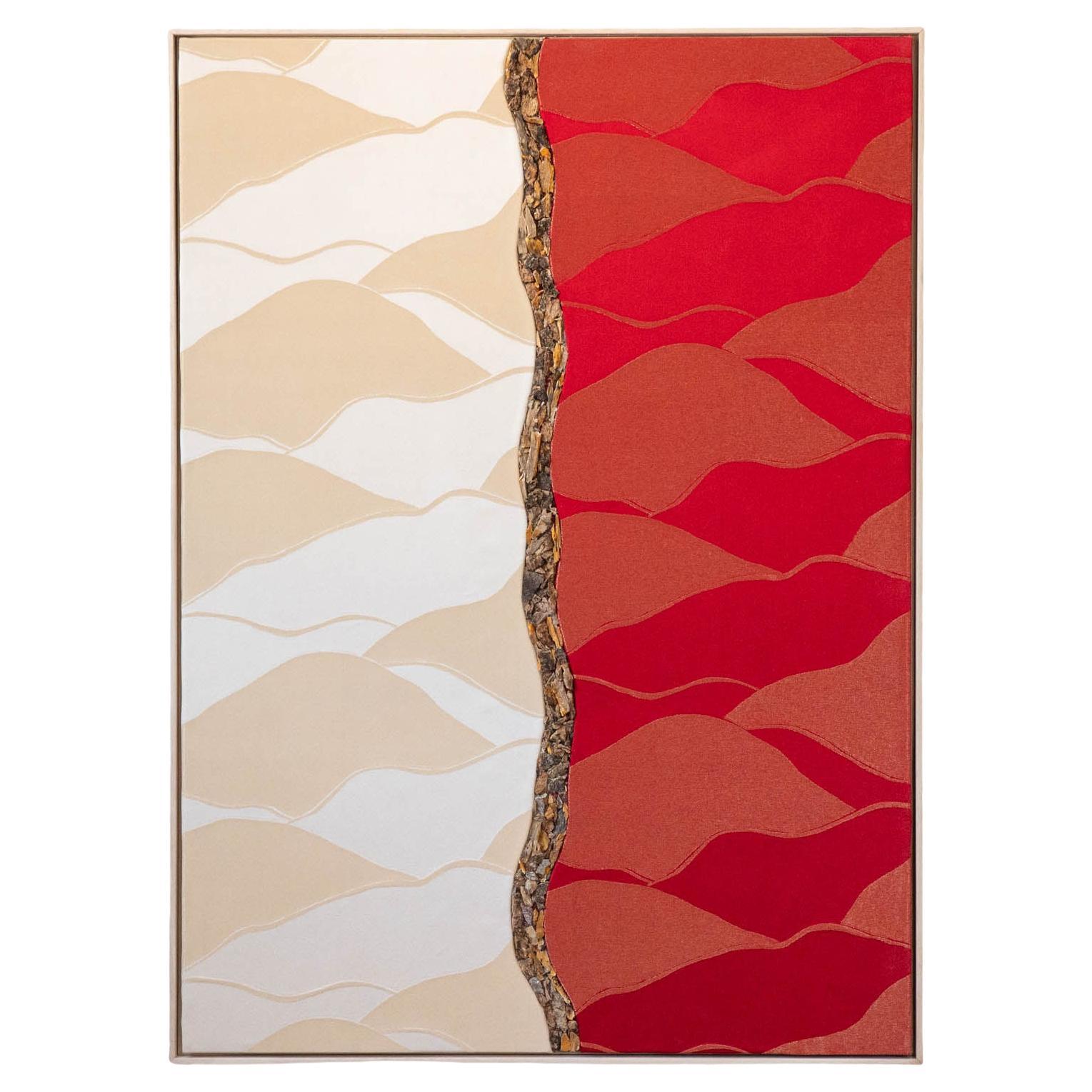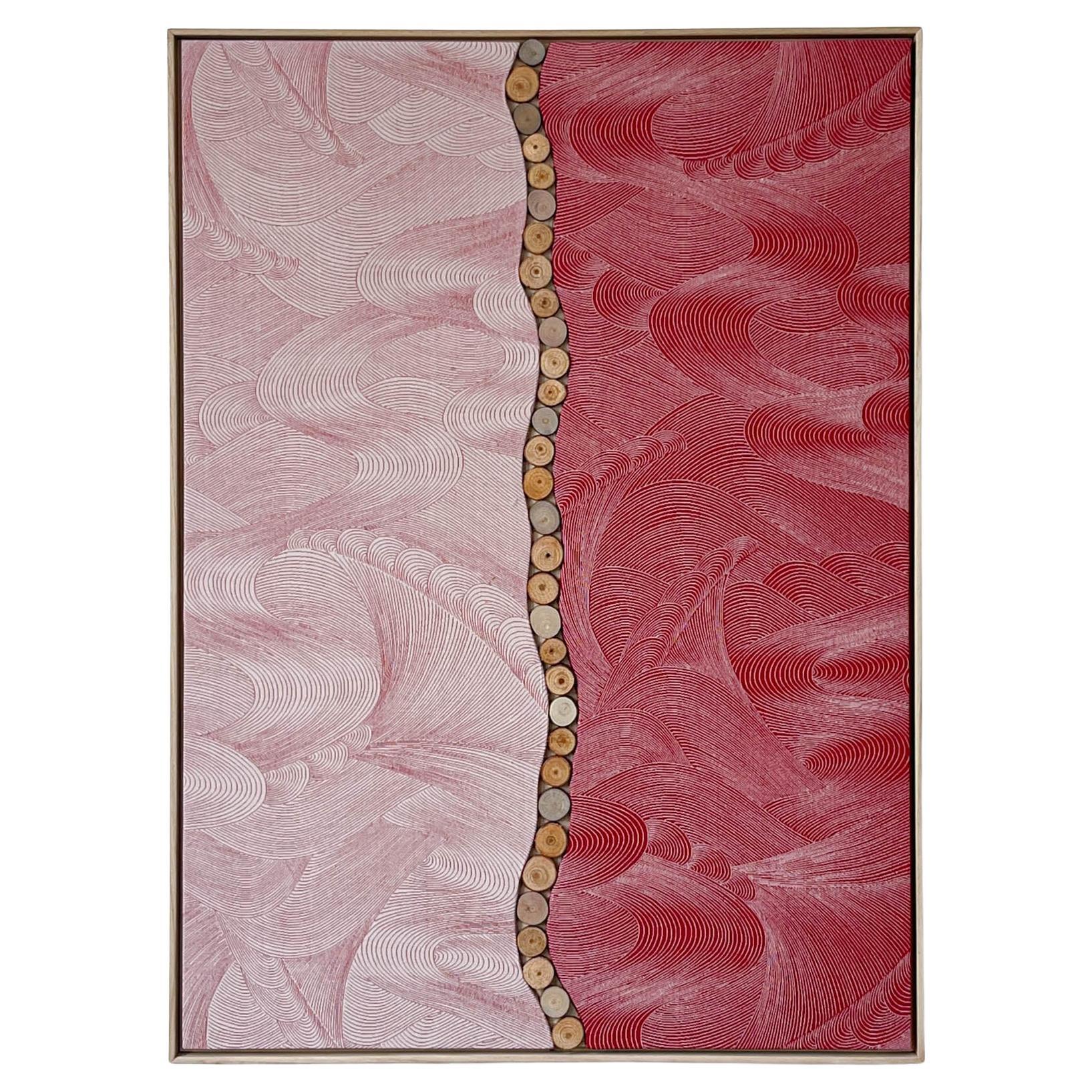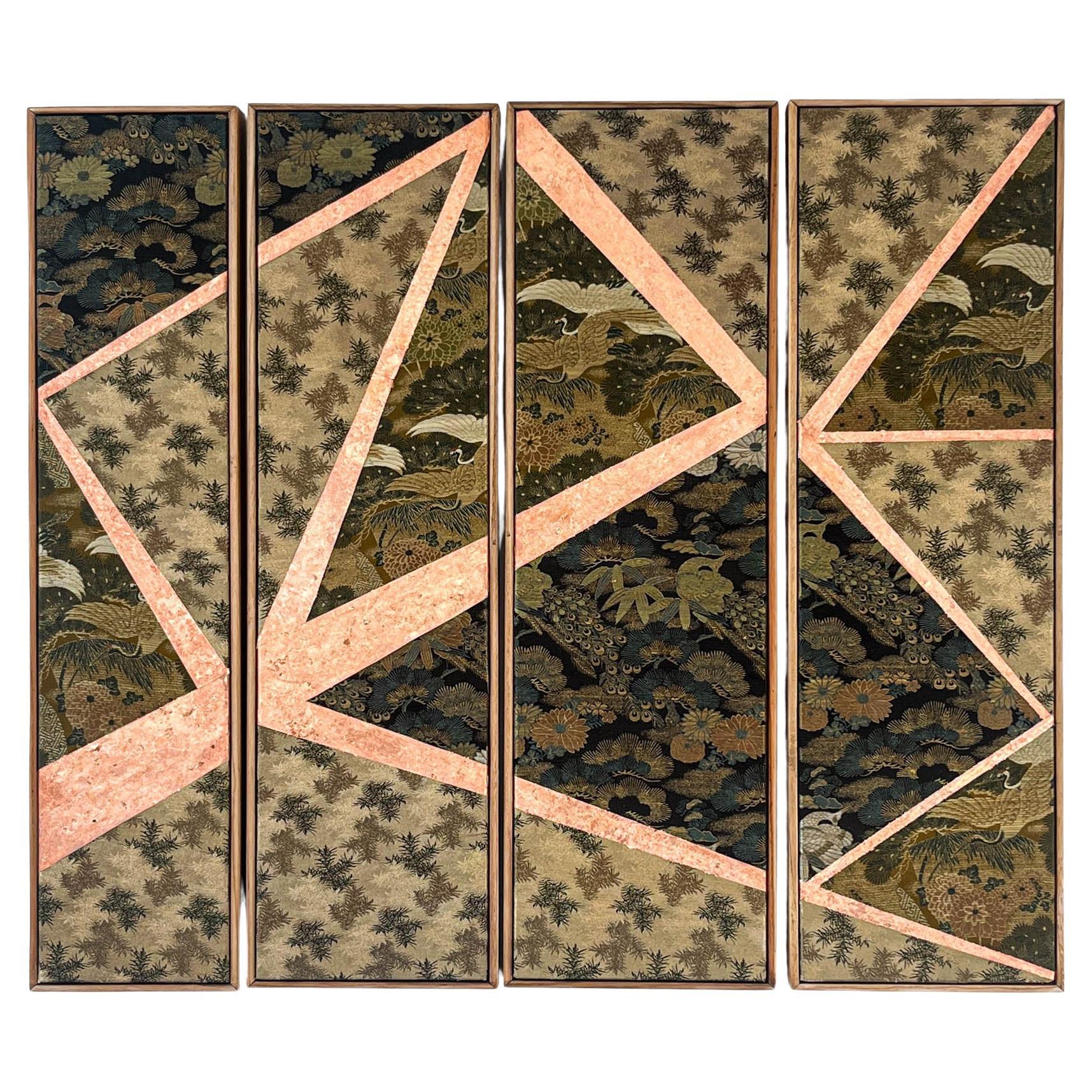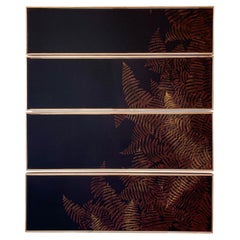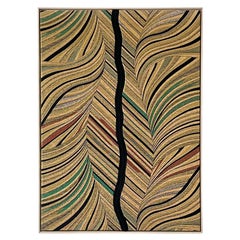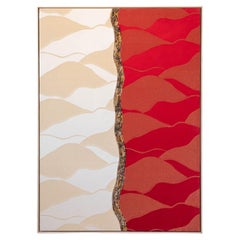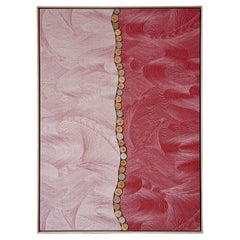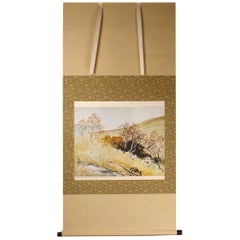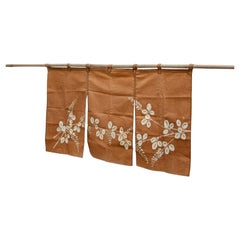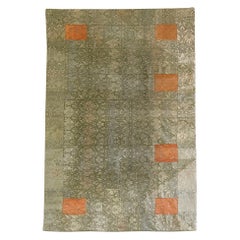Items Similar to Vintage kimono textile art "Autumn branches ~ Kintsugi ~" by ikasu Brown, Japan
Want more images or videos?
Request additional images or videos from the seller
1 of 12
Vintage kimono textile art "Autumn branches ~ Kintsugi ~" by ikasu Brown, Japan
$2,200
£1,682.02
€1,937.34
CA$3,082.87
A$3,441.74
CHF 1,803.42
MX$42,130.27
NOK 22,903.45
SEK 21,595.04
DKK 14,458.60
Shipping
Retrieving quote...The 1stDibs Promise:
Authenticity Guarantee,
Money-Back Guarantee,
24-Hour Cancellation
About the Item
The frame for this work is made of paulownia wood taken from antique Kiritansu - chest-of-drawers for kimono.
I use antique kiritansu that can’t be used as furniture anymore to create basis and frames for my works. It adds them even more authentic atmosphere of traditional wabisabi spirit. Can you feel it?
The piece uses the concept of "kintsugi" - it "unites" the pieces of antique kimono back together with golden washi paper to give it a second wind as art work.
<< Period / Story >>
The kimono used in this piece was originally crafted during the late Showa period (1960-80ies).
<< Explanation of colors and patterns >>
This piece features a modern arrangement with gold Japanese traditional washi paper running through the shades of brown stripes depicting branches and leaves.
The shades of brown stripes, upon closer inspection, reveal intricate "fawn pattern 鹿の子模様" dyeing, adding depth and complexity to the design. The origin of the "fawn pattern" lies in a tie-dyeing technique called "fawn pattern tie-dyeing," where the cloth is folded into quarters around a circular point and repeatedly tied with thread about seven to eight times before dyeing. The areas tied with thread remain white and square-shaped, with the tips of the corners lightly dyed to appear as dots, resembling the white spotted patterns on a fawn's back, hence the name. Deer are considered messengers of the gods and symbols of good fortune, vitality, and fertility, often used to represent "prosperity in descendants."
The depicted branches and leaves are delicately outlined with gold leaf, making the pattern stand out from the background and adding subtle elegance.
During the late Edo period (19th cent.), the shogunate enacted laws prohibiting luxury, leading townspeople in Edo to incorporate delicate nuances into dark colors like brown and gray, resulting in a wide range of colors and new "color names" being coined on various occasions, creating a diverse array of colors known as "Forty-eight Teas and a Hundred Mice 四十八茶百鼠."
<< Characteristics of the fabric >>
"Kimpaku" (金箔) -technique of gold dyeing on leaves, refers to the application of gold leaf onto various surfaces. In the context of kimono, kimpaku is used as a decorative technique to add luxuriousness, elegance, and a sense of opulence to the textile. Kimpaku is used to create intricate patterns, motifs, or designs, adding shimmering accents and highlights.
Kimpaku is used here to embellish traditional motif of leavevs, enhancing the overall aesthetic appeal of the fabric.
The process of applying kimpaku requires skill and precision. Ultra-thin sheets of gold leaf are carefully adhered to the fabric using an adhesive. Artisans use specialized techniques such as hand-painting or stenciling to create the desired design before applying the gold leaf. After the gold leaf is applied, it is delicately burnished to ensure a smooth and even finish.
Kimpaku has been used in Japanese textiles for centuries, particularly in garments worn by the nobility and aristocracy. Today, it continues to be employed in the creation of high-end kimono for special occasions such as weddings, ceremonies, or formal events, like this piece.
The use of kimpaku in kimono represents a fusion of artistic expression, craftsmanship, and cultural tradition. It serves as a symbol of wealth, prosperity, and refinement, adding a touch of extravagance to the fabric and elevating its status as a work of art.
<< About the frame >>
This artwork frame is crafted from paulownia wood, a uniquely Japanese material closely tied to the world of kimonos, and it serves to convey the refined beauty of Japanese nature.
Paulownia wood is known as the lightest wood in Japan, prased for its natural luster, resistance to moisture, and resilience against cracking. Since ancient times, it has been used in crafting furniture, chests, and musical instruments.
Paulownia wood is closely linked to kimono culture. During the Edo period, it became customary to store cherished kimonos in paulownia chests, which offered fire resistance and protection from moisture and insects.
Traditionally, when a daughter was born, a paulownia tree would be planted. Upon her marriage, the tree would be cut down, and the wood would be used to craft a chest for her as a wedding gift.
Following the Ansei Earthquake during the late Edo period in 1855, paulownia chests gained popularity due to their ability to withstand fires and even float in water, thereby safeguarding their contents during floods.
- Creator:Kimono ikasu (Artist)
- Dimensions:Height: 28.75 in (73 cm)Width: 20.87 in (53 cm)Depth: 1.97 in (5 cm)
- Style:Japonisme (In the Style Of)
- Materials and Techniques:
- Place of Origin:
- Period:
- Date of Manufacture:around 1960ies
- Condition:
- Seller Location:Setagaya City, JP
- Reference Number:1stDibs: LU10079243303632
About the Seller
No Reviews Yet
Vetted Professional Seller
Every seller passes strict standards for authenticity and reliability
1stDibs seller since 2024
- ShippingRetrieving quote...Shipping from: Setagaya City, Japan
- Return Policy
Authenticity Guarantee
In the unlikely event there’s an issue with an item’s authenticity, contact us within 1 year for a full refund. DetailsMoney-Back Guarantee
If your item is not as described, is damaged in transit, or does not arrive, contact us within 7 days for a full refund. Details24-Hour Cancellation
You have a 24-hour grace period in which to reconsider your purchase, with no questions asked.Vetted Professional Sellers
Our world-class sellers must adhere to strict standards for service and quality, maintaining the integrity of our listings.Price-Match Guarantee
If you find that a seller listed the same item for a lower price elsewhere, we’ll match it.Trusted Global Delivery
Our best-in-class carrier network provides specialized shipping options worldwide, including custom delivery.More From This Seller
View AllVintage kimono textile art "Fern ~Connection to Nature~" by ikasu Black , Japan
By Kimono ikasu
Located in Setagaya City, JP
This work uses an antique tomesode (festive kind of kimono) with fern design to evoke feelings of tranquility, harmony, and appreciation for the beauty of the environment. Can be used both vertically and horizontally.
It is elegantly framed with paulownia wood originally used for kimono chest-of-drawers, and is filled with storytelling and sense of luxury.
I used pieces of kimono that could no longer be used as clothing and kiritansu chest-of-drawers that would normally be discarded to create the ultimate upcycled piece.
<< Explanation of colors and patterns >>
In Japanese traditional culture, ferns, particularly the Japanese painted fern (Athyrium niponicum), hold several meanings and symbolisms:
・Elegance and Beauty: Ferns are admired for their graceful, delicate appearance and intricate leaf patterns. In Japanese aesthetics, they are appreciated for their natural beauty and are often used in gardens, landscapes, and floral arrangements to add a sense of refinement and elegance.
・Resilience and Perseverance: Ferns are known for their ability to thrive in diverse environments, including shady forests, rocky cliffs, and damp soil. Their resilience in the face of challenging conditions is seen as a symbol of endurance and perseverance. In Japanese culture, ferns may represent the ability to overcome adversity and flourish despite obstacles.
・Connection to Nature and Tranquility: Ferns are native to forested areas and are often associated with the natural world. In Japanese traditional culture, they symbolize a deep connection to nature and the importance of maintaining harmony with the environment. The lush green foliage of ferns evokes feelings of tranquility and peacefulness, making them popular motifs in Zen gardens and traditional landscape paintings.
・Purity and Simplicity: Ferns are emblematic of simplicity and purity in Japanese aesthetics. Their unassuming beauty and understated elegance reflect the principles of wabi-sabi, an aesthetic worldview that values imperfection, impermanence, and simplicity. Ferns may be used in tea ceremonies, Ikebana (flower arranging), and other traditional arts to evoke a sense of tranquility and appreciation for life's fleeting moments.
Overall, ferns in Japanese traditional culture symbolize elegance, resilience, connection to nature, purity, and simplicity. Their presence in art, literature, and landscape design underscores their enduring significance as symbols of natural beauty and spiritual resonance.
<< Characteristics of the fabric >>
This vintage textile is hand-painted with a traditional Japanese technique called "yuzen".
<< About the frame >>
Kiritansu - chest-of-drawers for kimono, is traditionally made from paulownia wood, a uniquely Japanese material closely tied to the world of kimonos.
Paulownia wood is known as the lightest wood in Japan, prased for its natural luster, resistance to moisture, and resilience against cracking. Since ancient times, it has been used in crafting furniture, chests, and musical instruments.
During the Edo period, it became customary to store cherished kimonos in paulownia chests...
Category
Vintage 1960s Japanese Japonisme Paintings and Screens
Materials
Silk, Wood
Vintage obi textile art "Broken Vase ~kintsugi~" by ikasu Black / Gold, Japan
By Kimono ikasu
Located in Setagaya City, JP
This textile artwork uses a vintage obi dated around 1980ies, with a feather motif, and arranges it so that it looks like a vase.
Antique obi, just as it is a broken vase, is united back again with black obijime - a string used to tie up obi when it’s worn. Framed in kiritansu (antique chest) paulownia wood.
It is elegantly framed with paulownia wood originally used for kimono chest-of-drawers, and is filled with storytelling and sense of luxury.
I used pieces of kimono that could no longer be used as clothing and kiritansu chest-of-drawers that would normally be discarded to create the ultimate upcycled piece.
<< Explanation and meaning of pattern and colors>>
Feathers hold various meanings and symbolism in Japanese traditional culture, often reflecting themes of spirituality, symbolism, and folklore. Here are some of the meanings associated with feathers in Japanese tradition:
・Divine Protection: Feathers are often seen as symbols of divine protection and spiritual guidance. Feathers, especially those from birds, are considered to be imbued with the protective energy, offering spiritual guardianship and safeguarding against negative forces.
・Connection to the Spirit World: Feathers are sometimes associated with the spirit world and the realm of the divine. In folklore and mythology, feathers are depicted as messengers between the earthly realm and the celestial realms.
・Symbol of Beauty and Elegance: Feathers are admired for their natural beauty, grace, and elegance. In traditional Japanese arts such as Noh theater, Kabuki, and dance performances like Kagura, actors and performers often use feathered costumes or accessories to enhance their appearance and convey a sense of refinement and sophistication.
・Sign of Good Luck and Prosperity: In Japanese folklore, certain birds like cranes and pheasants are considered symbols of good fortune, longevity, and prosperity. Feathers from these birds are often depicted in art and craftwork as auspicious symbols believed to bring blessings and positive energy to the bearer.
<>
Kiritansu - chest-of-drawers for kimono, is traditionally made from paulownia wood, a uniquely Japanese material closely tied to the world of kimonos.
Paulownia wood is known as the lightest wood in Japan, prased for its natural luster, resistance to moisture, and resilience against cracking. Since ancient times, it has been used in crafting furniture, chests, and musical instruments.
During the Edo period, it became customary to store cherished kimonos in paulownia chests...
Category
Vintage 1980s Japanese Japonisme Paintings and Screens
Materials
Silk, Wood
Vintage obi textile art "Under the Sun ~Serendipity " by ikasu Red / Beige Japan
By Kimono ikasu
Located in Setagaya City, JP
This artwork creatively uses tree bark to evoke the imagery of woods and mountains during both the morning and nighttime on left and right. It is elegantly framed with paulownia wood, a tree closely connected to kimono culture, and is filled with storytelling and sense of luxury.
By incorporating both the front and back sides of the same obi fabric woven in different colors, the play of light and shadow on the mountains is depicted through the contrasting appearances of these surfaces.
The intention behind this piece is to convey the exquisite beauty of Japanese mountains and the lush forests that inhabit them. To achieve this, traditional elements of Japanese culture, such as obi textiles and craftsmanship involving wood, were used.
The outer side and inner linings of the same obi, no longer suitable for clothing, along with bark material that would normally be discarded, have been repurposed to create this exceptional upcycle artwork.
The fusion of Japanese natural materials – silk, paulownia wood, and pine bark for the central decoration – along with the so-called "Tozan" pattern, a unique Japanese natural design showing mountains from far-away point, captures the magnificent beauty of Japanese nature from various perspectives.
The central bark decoration stands out as a distinctive feature of this work. Pine, oak, and other tree barks are interwoven among the mountains woven into the obi, creating a tangible and authentic natural atmosphere.
<< Period / Story >>
The obi used in this piece was originally crafted during the late Showa period (1960-80ies).
<< Explanation and meaning of pattern and colors >>
This upcycle artwork uses an obi with a tozan pattern woven in two colors. The design is inspired by a distant mountain range, a motif that has been used in paintings and crafts since ancient times. However, in this particular design, the mountains are depicted not as distant peaks but as graceful semicircles giving it a mild atmosphere.
<< Characteristics of the fabric >>
This upcycled Fukuro-obi (two-side obi) showcases a festive color pattern of mountains intricately woven with gold threads against a beige front and red on the back.
The way this obi interacts with light allows it to shift in expression, much like a mountain revealing different facets over time. It can transform from deep shades of color to the appearance of gold shimmering against bright hues, depending on the lighting and viewing angle.
<< About the frame >>
Kiritansu - chest-of-drawers for kimono, is traditionally made from paulownia wood, a uniquely Japanese material closely tied to the world of kimonos.
Paulownia wood is known as the lightest wood in Japan, prased for its natural luster, resistance to moisture, and resilience against cracking. Since ancient times, it has been used in crafting furniture, chests, and musical instruments.
During the Edo period, it became customary to store cherished kimonos in paulownia chests...
Category
Late 20th Century Japanese Japonisme Paintings and Screens
Materials
Silk, Wood
Vintage kimono textile art "Sunset Timelapse ~Ephemerality~" by ikasu Red, Japan
By Kimono ikasu
Located in Setagaya City, JP
The art piece uses two sides - front and reverse - of the same kimono, to show beautiful sea surrounding Japan, in hues and in late sunset, as a timelapse.
The frame for this work is made of paulownia wood taken from antique Kiritansu - chest-of-drawers for kimono.
I use antique kiritansu that can’t be used as furniture anymore to create basis and frames for my works. It adds them even more authentic atmosphere of traditional wabisabi spirit. Can you feel it?
<< Period / Story >>
The kimono used in this piece was originally crafted during Showa period (around 1960ies).
<< Explanation and meaning of pattern and colors >>
Sea waves, depicted in two color variations here, are a symbol of transience and Impermanence in Japanese culture. The ebb and flow of the tides, the ever-changing currents, and the relentless motion of the waves serve as reminders of the fleeting nature of life. This artwork featuring the sea convey themes of impermanence, reminding viewers to cherish the present moment and appreciate the beauty of life's fleeting moments.
The theme of impermanence is strengthen by two colors of the sea - the lighter in early hues and the darker when the sun is just about to set in the sea.
<< About the frame >>
This artwork frame is crafted from paulownia wood, a uniquely Japanese material closely tied to the world of kimonos, and it serves to convey the refined beauty of Japanese nature.
Paulownia wood is known as the lightest wood in Japan, prased for its natural luster, resistance to moisture, and resilience against cracking. Since ancient times, it has been used in crafting furniture, chests, and musical instruments.
Paulownia wood is closely linked to kimono culture. During the Edo period (17th cent.~), it became customary to store cherished kimonos in paulownia chests...
Category
Vintage 1960s Japanese Japonisme Paintings and Screens
Materials
Silk, Wood
Antique kimono textile art "Prosperity Tree" by ikasu Black, Japan
By Kimono ikasu
Located in Setagaya City, JP
This work uses an antique kimono fabric dated Taisho era (early 1910th), with a pine tree motif, and arranges it so that it looks like a tree decorated with various auspicious symbols - persimmons, pines, peonies, etc.
The line in the middle symbolizes “kintsugi” - concept of wabi-sabi, which values imperfection, impermanence, and the beauty of aging.
It is elegantly framed with paulownia wood originally used for kimono chest-of-drawers, and is filled with storytelling and sense of luxury.
I used pieces of kimono that could no longer be used as clothing and kiritansu chest-of-drawers that would normally be discarded to create the ultimate upcycled piece.
<< Explanation and meaning of pattern and colors >>
The art work features the matsu - pine pattern, which depicts the Japanese pine tree spreading over deep black fabric. It appears as if the pine dranches are decorated with various auspicious symbols - persimmons, pines, peonies, etc.
In East Asia, the pine tree is revered as a symbol of longevity due to its vibrant green leaves, even during the winter season.
In Japan, it's often referred to as the "evergreen tree" because its leaves remain green throughout the year, making it a symbol of good fortune that has been cherished for a long time.
<< Characteristics of the fabric >>
The fabric is hand-painted in traditional Japanese technique "yuzen".
<< About the frame >>
Kiritansu - chest-of-drawers for kimono, is traditionally made from paulownia wood, a uniquely Japanese material closely tied to the world of kimonos.
Paulownia wood is known as the lightest wood in Japan, prased for its natural luster, resistance to moisture, and resilience against cracking. Since ancient times, it has been used in crafting furniture, chests, and musical instruments.
During the Edo period, it became customary to store cherished kimonos in paulownia chests...
Category
Early 20th Century Japanese Japonisme Paintings and Screens
Materials
Gold Leaf
Antique obi textile art " Pine forest ~ Longivety ~ " by ikasu Green , Japan
By Kimono ikasu
Located in Setagaya City, JP
<< Story behind the work >>
Obi fabric I used for this artwork is taken from three different over 100-years-old antique sashes, and is framed in wood taken from antique chest-of-dra...
Category
Early 20th Century Japanese Japonisme Paintings and Screens
Materials
Gold Leaf
You May Also Like
Autumn landscape 20th Century Scroll Painting Japan Artist Kawagoe Tamado
Located in Amsterdam, Noord Holland
It is a high-class craft of the work drawn by Kawagoe Tamado as you can see.
It is the "late autumn in the highlands" where you can feel the taste of autumn, and it is
a work in which the trees and flowers that sway in the wind shine well.
«Kawagoedado»
[1873-1957] Japanese painter. Born in Aichi.
His real name is Hosaburo. Another issue, Ikuan.
At the beginning, he studied under the Shijo school and then Masakuni Hashimoto to...
Category
Early 20th Century Japanese Taisho Paintings and Screens
Materials
Silk
$2,032 Sale Price
20% Off
Japanese Persimmon-Dyed Noren with Floral Motif, Taisho Period, 1910s
Located in Edogawa-ku Tokyo, JP
A charming small-scale Japanese noren (traditional fabric divider), hand-dyed using natural persimmon tannin, dating to the Taisho period. This textile piece features a delicate whi...
Category
Early 20th Century Japanese Textiles
Materials
Fabric
Antique Japanese Brocade Monk's Robe Kesa Meiji Period
Located in Atlanta, GA
A Japanese Kesa (Monk's Vestment) made from thirteen columns of patchworks of shimmering woven brocades. The elaborate motifs feature repetitive elaborat...
Category
Antique Late 19th Century Japanese Meiji Textiles
Materials
Brocade, Silk
Silk Scroll Painting by Matsumura Keibun, 18th Century
By Matsumura Keibun
Located in New York, NY
A silk parchment scroll with a Camellia Flower painting, by Japanese artist Matsumura Keibun (1779-1843).
The younger half-brother to Matsumura Goshun, founder of the Shijo schoo...
Category
Antique 1790s Asian Edo Paintings and Screens
Materials
Silk, Parchment Paper
Antique Japanese Embroidery Tapestry Panel Edo Period
Located in Atlanta, GA
A large Japanese silk embroidery tapestry circa 18th century Edo period. Possibly an altar tablecloth originally, the embroidered textile pane...
Category
Antique 18th Century Japanese Edo Textiles
Materials
Silk
$3,200 Sale Price
20% Off
Superb Japanese Landscape Scroll with Sakura and Bamboo, 16th–17th Century
Located in Fukuoka, JP
A refined and poetic Japanese landscape painting dating from the late Muromachi to early Edo period (16th–17th century). Executed in mineral pigments on paper, the composition captur...
Category
Antique Early 17th Century Asian Edo Paintings and Screens
Materials
Gold Leaf
More Ways To Browse
Textile Art
Vintage Textile Art
Tree Branch Furniture
Fertility Art
Japanese Fabric Art
Washi Paper Japanese
Japanese Kimono
Japanese Used Kimono
Tea Chest
Framed Japanese Textiles
Vintage Kimonos
Vintage Silk Screens
Gold Kimono
White Kimono
19th Century Fire Screen
Vintage Wood Tree Stands
Painted And Stenciled Furniture
Vintage Plant Waterer
